WINKHAUS BCP-NG Programming Device
Specifications
- Model: BCP-NG
- Color: BlueSmart design
- Interfaces: RS 232, USB
- Power supply: External power supply
Description of Components:
The programming device BCP-NG consists of various components
Including:
- Connection socket for adapter cable
- Illuminated display
- Navigation switch
- Connection socket for power adapter
- Slot for the electronic key
- RS 232 interface
- USB interface
- Type plate
- Pushbutton for opening the battery housing
- Cover plate of the battery housing
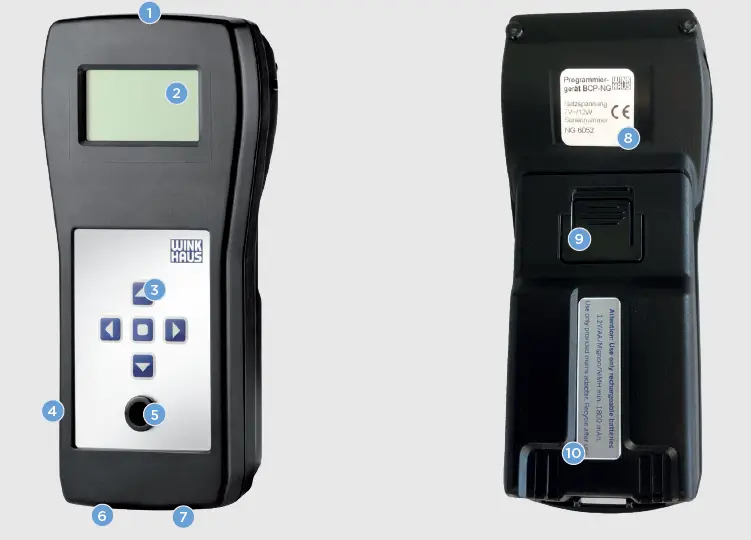
Standard Accessories:
The standard accessories included in the delivery are:
- USB cable Type A/A
- Type A1 connecting cable to the cylinder
- Power pack for external power supply
- Type A5 connecting cable to the reader and the intelligent door handle (EZK)
- Adapter to hold a mechanical key with a blueChip or blueSmart transponder

First Steps
- Ensure that the programmer drivers are installed. The drivers are generally installed automatically along with the administration software. They are also available on the accompanying installation CD.
- Connect the programming device to your PC using the accompanying USB cable (or RS 232 connection cable).
- Launch the electronic locking system administration software on your PC and follow the instructions on the screen.
- The software will then check whether a firmware update is available for your programming device.
- If there is, the update must be installed.
 Note: If you are managing different systems, no transactions (data) may be open in the programming device memory when changing from one system to another.
Note: If you are managing different systems, no transactions (data) may be open in the programming device memory when changing from one system to another.
Switching On/Off:
- To switch it on, please push the middle of the navigation switch (3).
- The start window is shown in the display.
- To switch off the device, push down on the middle of the navigation switch (3) for approx. 3 sec. The BCP-NG switches off.
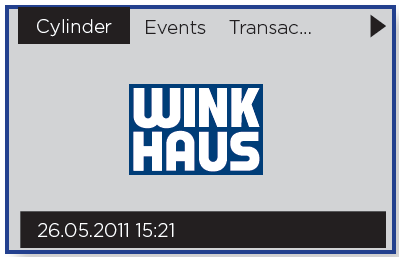
Energy-saving Function:
To avoid unnecessary energy consumption during battery operations, the BCP-NG device is provided with an energy-saving function. When the device has not been operated for three minutes, a message is shown in the display (2), informing the user that the device will switch off after 40 seconds. During the last 10 seconds, an additional acoustic signal is heard.
If the device is being powered using a powerpack supply, the power saving function is disabled and the BCP-NG will not switch off automatically.
Navigation:
The navigation Switch (3) provides several directional buttons „ ![]() “, „ “, „
“, „ “, „![]() “,
“,![]() „ “ whi
„ “ whi![]() ch help to make navigation through the menus and submenus easy.
ch help to make navigation through the menus and submenus easy.
The background of the selected menu will be highlighted in black. By pushing the „ “![]() button, the corresponding submenu is opened.
button, the corresponding submenu is opened.
You can activate the required function by pushing the „•“ button in the middle of the navigation switch. This button simultaneously incorporates the “O.K.” function. Even if the submenu should not be visible, pushing the ![]() „ “ und
„ “ und ![]() „ “ buttons leads you either to the preceding or the following menu item.
„ “ buttons leads you either to the preceding or the following menu item.
Data Transmission:
You will have the possibility of connecting the BCP-NG device either with the enclosed USB cable (11), or you can use an RS232 cable (optionally available) for making a connection to a PC. Please install the drivers that are available on the supplied CD first. First, please install the drivers from the CD that has and provided. The individual settings for the interface can be found in the responding installation instructions of the software. The BCP-NG is now ready for operations.
Using the Programming Adapter On-Site:
Installation is prepared on the PC with the aid of the management software. After the required information has been transferred to the BCP-NG, connect the device to the blueChip/blueSmart components in question using the respective adapter cable.
Please note: You need the type A1 adapter for cylinders. Insert the adapter, turn it about 35°, and it will lock into position. You need to use a type A5 adapter if you are using readers and the intelligent door handle (EZK).
Menu Structure:
The menu structure includes options for programming, identifying cylinders, managing events and transactions,and working with keys, tools, and configurations.
| Cylinder | Program |
| Identify | |
| Ebents | Read out |
| Display | |
| Transactions | Open |
| Error | |
| Key | Identify |
| Tools | Power adapter |
| Synchronise time | |
| Battery replacement | |
| Configuration | Contrast |
| Firmware version | |
| System |
Setting the time of the BCP-NG:
The device contains a quartz clock, which is powered separately. The clock will thus continue to function even when the battery is flat or removed. If the time shown on the display is not correct, you can readjust it.
If you use BCBC software version 2.1 or higher, proceed as described in the software.
Application notes:
Programming a cylinder:
Information, which has been generated in advance by using in the application software, can be transferred with this menu to the blueChip/blueSmart components, such as cylinders, readers, an EZK. Connect the BCP-NG with the component and push OK („•“).
The programming procedure is activated automatically. The various steps, including confirmation, can be monitored on the display (Figure 4.1).
Push on OK after the programming has been completed. Use the navigation buttons„ ![]() “ und „
“ und „ ![]() “ to return to the main menu.
“ to return to the main menu.

Identifying a cylinder:
If the locking system or the locking number should no longer be readable, then the cylinder, the reader or the EZK can be identified.
After the BCP-NG has been connected to the cylinder, please confirm with OK („•“). All relevant data, such as the cylinder number, the locking system number, cylinder time (for cylinders with a time feature), the number of locking operations, the cylinder name, the version number, and the number of locking operations after an replacement of the battery, are shown on the display (Figure 4.2).
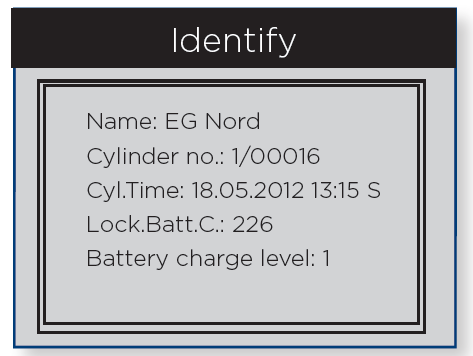
By pushing the “down” button („ “), you can view additional information (Figure 4.3).
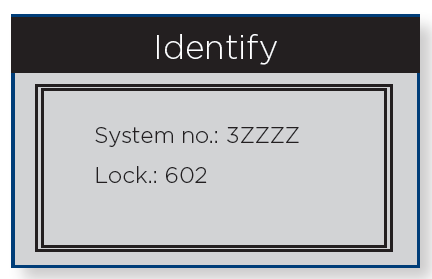
You can call up those transactions that are stored in the BCP-NG. You can choose either the open or the incorrect transactions to be indicated. Incorrect transactions are marked with an „x“ (Figure 4.4).
Transactions:
You can call up those transactions that are stored in the BCP-NG. You can choose either the open or the incorrect transactions to be indicated. Incorrect transactions are marked with an „x“ (Figure 4.4).
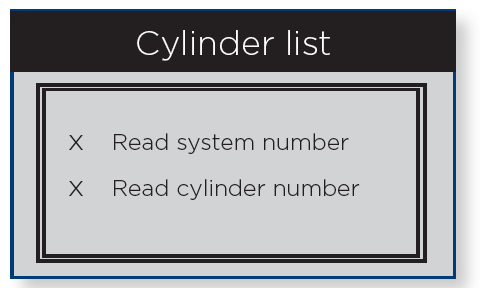
Key:
As with cylinders, you also have the option of identifying and assigning keys/cards.
To do so, insert the key that you wish to identify in the slot on the BCP-NG (5) or place the card on top and confirm by pressing OK („•“). The display will now show you the key’s or the card’s system number and lock number (Figure 4.5).
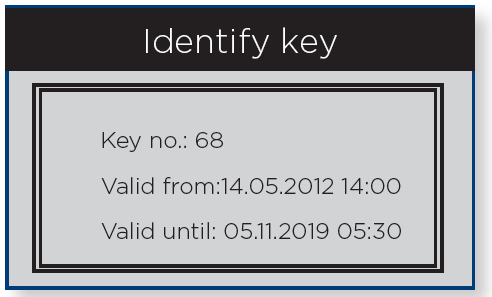
Events:
- The last locking transactions, so-called “events”, are stored in the cylinder, reader or EZK. This menu can be used for reading out these events and displaying them.
- To do this, the BCP-NG is connected with a cylinder, a reader or an EZK. After having confirmed the process with the „•“ button, the read-out process is activated automatically. A successful conclusion of the read-out process will be confirmed (Figure 4.6).
- Now you can view the events by selecting the menu item “Show events”. The display will then show the events that have been read out (Figure 4.7).
The authorised locking processes are marked „ “, and the unauthorised locking attempts are marked „x“.


Tools:
This menu item contains the power adapter function, time synchronisation, and the option of logging battery replacement. The power adapter function only allows you to open doors for which you have an authorised identification medium. The BCP-NG receives information when you insert the key into the device (5) or place the card on top of the BCP-NG. To do so, use the navigation to select the “Tools” section and then select the “Power adapter” function.
Follow the different steps on the display. When you insert the adapter cable into the cylinder, turn it about 35° against the locking direction until it locks into position. Now, press the „•“ key and turn the adapter in the locking direction in the same way that you would turn a key in the cylinder.
- Due to environmental influences, there may be differences between the displayed time and the actual time over the course of time when electronic components are operating.
- The “Synchronise clock time” function allows you to set the time on a cylinder, reader, or EZK. If there should be any differences, you can use the “Synchronise clock time” menu item to match the time on the components with the time on the BCP-NG (Figure 4.8).
- The time on the BCP-NG is based on the system time on the computer. If the cylinder time differs more than 15 minutes from the system time, you will be required to authenticate it again by placing the programming card on top.
- The “Battery replacement” function allows you to indicate the counter reading on the cylinder, reader, or EZK when the battery was replaced. This information is then processed by the BCBC software version 2.1 or higher. To do so, connect the BCP-NG to the electronic component and follow the instructions on the display (2)
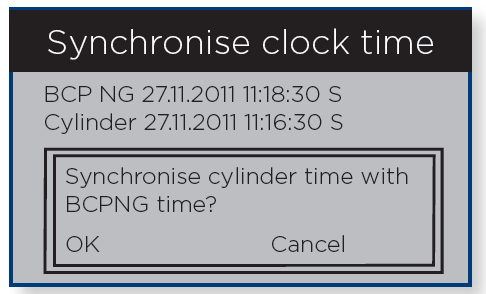
Configuration:
This is where you can adjust the BCP-NG to your needs by setting the contrast. You will find the installed firmware version in this section. The language setting on the BCP-NG is matched to that on the software in blueControl version 2.1 and higher, so there is no need to adjust the settings.
Power supply/Safety instructions:
A battery box is located at the underside of the BCP-NG, into which four rechargeable batteries of the type AA can be inserted. The BCP-NG is delivered with a set of rechargeable batteries. To open the battery box, push down the pushbutton (9) at the back and pull down the cover plate (10). Disconnect the plug of the power adapter before opening the cover plate of the battery box.
Electrical power supply and security instructions for BCP-NG:
Warning: Only use rechargeable batteries with the following specifications: Nominal voltage 1.2 V, size NiMH/AA/Mignon/HR 6, capacity 1800 mAh and larger, suitable for quick loading.
Warning: In order to avoid unacceptably high exposure to electromagnetic fields, the programming adapters must not be placed closer than 10 cm to the body when in operation.
- Recommended manufacturer: GP 2700 / C4 GP270AAHC
- Please only use original Winkhaus accessories and components. This helps to prevent possible health and material damages.
- Do not change the device in any way.
- The device may not be operated with normal batteries (primary cells). Charging other than the recommended type of rechargeable batteries, or charging batteries that cannot be recharged, can lead to health hazards and material damages.
- You must observe the local legal regulations when disposing of unusable batteries.
- Only use the supplied power adapter; the use of any other device can lead to damages or hazards for health. Never operate a power adapter that shows visible signs of damage, or if the connecting cables are visibly damaged.
- The power adapter for recharging batteries should only be used in enclosed rooms, in dry surroundings, and with a maximum ambient temperature of 35 °C.
- It is entirely normal that batteries warm up, which are being charged or are in operation. It is therefore recommended to position the device on a free surface. And the rechargeable battery is that may not be replaced when the power adapter is connected, namely during charging operations.
- Please observe the correct polarity when replacing the rechargeable batteries.
- If the device is stored for a longer period and at an ambient temperature above 35 °C, this may lead to a spontaneous and even a total discharge of the batteries. The input side of the power adapter is provided with a self-resetting protection facility against overload current. If it is triggered, then the display goes out, and the device cannot be switched on. In such an event, the error, for instance, a defective battery, must be removed, and the device must be disconnected from mains power for approximately 5 minutes.
- According to manufacturer specifications, rechargeable batteries can usually be used in a temperature range from -10 °C to +45 °C.
- The output capacity of the battery is strongly limited at temperatures below 0 °C. Winkhaus therefore recommends that a use at less than 0 °C is to be avoided.
Charging the rechargeable batteries:
The batteries are recharged automatically once the device is connected with the power cable. The battery status is shown by a symbol on the display. Batteries last for about 12 hours. Recharging time is a max. of 8 hours.
Note: The rechargeable batteries are not loaded when the BCP-NG is delivered. To charge the batteries, first connect the supplied power adapter with a 230 V socket and then with the BCP-NG. When the supplied batteries are being charged for the first time, the loading time amounts to approximately 14 hours.
Ambient conditions:
Battery operation: -10 °C to +45 °C; operation with power supply unit: -10 °C to +35 °C. For indoor use. In the case of low temperatures, the device should be additionally protected by insulation. Protection class IP 20; prevents condensation.
Update of the internal software (firmware) :
Please first verify whether the additional “BCP-NG Tool” is installed on your computer. It is part of the installation CD, which is supplied with the BCP-NG programming device and is standardly saved on the path:
C:\Programme\Winkhaus\BCP-NG\BCPNGToolBS.exe
The current firmware can be obtained from Winkhaus on the phone number +49 251 4908 110.
Warning:
During the firmware update, the power supply unit must not be separated from the BCP-NG!
- Please connect the BCP-NG device to the power supply unit.
- After that, the BCP-NG is connected with the PC by means of the USB cable or the serial interface cable.
- The current firmware (e.g. TARGET_BCPNG_028Z_EXT_20171020.030) is saved on the installation path (standardly C:\Programme\Winkhaus\ BCP-NG) of the BCP-NG. Only one update file at a time can be stored in the folder. If you performed any updates before, please remember to delete the old downloads.
- Now , the BCP-NG tool is ready to be started.
- On the start interface you can now search for the connection of the BCP-NG using “All ports” or it can be selected directly via the dropdown menu. The process is started by pressing the “Search” button.
- After finding the port, you can start the update by pressing the “update” button.
- After successful installation, the new version is indicated in the pop-up window.
Error codes:
To facilitate error management, the BCP-NG will show the currently applicable error codes on the display. The meaning of these codes is defined in the following list.
| 30 | Adaptation failed | • No cylinder inserted • Defective cylinder • Cylinder battery weak/empty |
| 31 | Identification failed | • Error-free reading of data was not possible |
| 32 | Cylinder programming failed (BCP1) | • Defective cylinder • Cylinder battery weak/empty |
| 33 | Cylinder programming failed (BCP-NG) | • Defective cylinder • Cylinder battery weak/empty |
| 34 | ‘Set new PASSMODE/UID’ request could not be carried out | • No cylinder inserted • Defective cylinder • Incorrect cylinder adaptation |
| 35 | The key block could not be read | • No key available • Defective key |
| 37 | Cylinder time could not be read | • Defective cylinder • No time module in the cylinder • Cylinder clock effective |
| 38 | Time synchronisation failed | • Defective cylinder • No time module in the cylinder • Cylinder clock effective |
| 39 | The power adapter failed | • No cylinder inserted • Defective cylinder • No authorised key |
| 40 | The counter for battery replacement could not be set | • No cylinder inserted • Defective cylinder |
| 41 | Update cylinder name | • No cylinder inserted • Defective cylinder • Cylinder battery weak/empty |
| 42 | Transactions were not carried out completely | • No cylinder inserted • Defective cylinder • Cylinder battery weak/empty |
| 43 | Data could not be transferred to the cylinder | • Adapter is not correctly connected • Cylinder battery weak/empty |
| 44 | Status could not be memorised | • Faulty memory element |
| 48 | The system card could not be read when setting the clock | • No system card on the programming device |
| 49 | Incorrect key data | • The key could not be read |
| 50 | Event information could not be read | • No cylinder inserted • Defective cylinder • Cylinder battery weak/empty |
| 51 | The event list does not fit into the BCP-NG memory | • Size of the event memory changed |
| 52 | The event list cannot be downloaded to the BCP-NG | • The event table is full |
| 53 | The event list was not completely read | • Communications problem with cylinder • No cylinder inserted • Storage media defective |
| 60 | Wrong locking system number | • The cylinder does not fit with the active locking system • No cylinder inserted |
| 61 | Pass mode could not be set | • Wrong password • No cylinder inserted |
| 62 | The cylinder number could not be read | • No cylinder inserted • Defective cylinder • Cylinder battery weak/empty |
| 63 | The event list was not completely read | • Communications problem with cylinder • No cylinder inserted • Storage media defective |
| 70 | Wrong locking system number | • The cylinder does not fit with the active locking system • No cylinder inserted |
| 71 | Pass mode could not be set | • Wrong password • No cylinder inserted |
| 72 | The cylinder number could not be read | • No cylinder inserted • Defective cylinder • Cylinder battery weak/empty |
| 73 | The event length could not be read | • No cylinder inserted • Defective cylinder • Cylinder battery weak/empty |
| 74 | Software configuration of the cylinder could not be read | • No cylinder inserted • Defective cylinder • Cylinder battery weak/empty |
| 75 | Software version of the cylinder could not be read | • No cylinder inserted • Defective cylinder • Cylinder battery weak/empty |
| 76 | Data exceeds the addressing range | |
| 77 | The event list does not fit into the memory area | • Cylinder configuration changed • Defective cylinder |
| 78The event | t list cannot be saved to memory. | • The memory area in BCP-NG is full |
| 79 | The event list was not completely read | • Communications problem with cylinder • No cylinder inserted • Storage media defective |
| 80 | The log table cannot be written | • TblLog is full |
| 81 | Incorrect cylinder communication | • No cylinder inserted • Defective cylinder |
| 82 | Counter readings and/or event headers could not be located | • No cylinder inserted • Defective cylinder |
| 83 | The battery counter in the cylinder could not be updated | • No cylinder inserted • Defective cylinder • Cylinder battery weak/empty |
| 84 | Battery replacement not possible | • Connection to cylinder faulty |
| 85 | It was not possible to move to the locking position after battery replacement (applies to types 61/15, 62, and 65 only) | • Connection to knob cylinder faulty |
| 90 | No time module found | • Defective cylinder • No time module in the cylinder • Cylinder clock effective |
| 91 | Cylinder time could not be set | • Defective cylinder • No time module in the cylinder • Cylinder clock effective |
| 92 | Time is wrong | • Time invalid |
| 93 | The memory could not be loaded | • Faulty memory element |
| 94 | Clock time on BCP-NG is not valid | • Clock time on BCP-NG not set |
| 95 | The time difference between cylinder and BCP-NG could not be established | • Clock time on BCP-NG not set |
| 96 | The log list cannot be read | • Log list full |
| 100 | The cylinder version could not be read | • kein Zylinder angesteckt • Zylinder defekt • Batterie Zylinder schwach/leer |
| 101 | The cylinder configuration could not be read | • No cylinder inserted • Defective cylinder • Cylinder battery weak/empty |
| 102 | The first events counter could not be read | • No cylinder inserted • Defective cylinder • Cylinder battery weak/empty |
| 103 | The counter of locking processes could not be read | • No cylinder inserted • Defective cylinder • Cylinder battery weak/empty |
| 104 | The counter of locking processes could not be read | • No cylinder inserted • Defective cylinder • Cylinder battery weak/empty |
| 105 | The counter of locking processes could not be loaded | • No cylinder inserted • Defective cylinder • Cylinder battery weak/empty |
| 106 | The counter of locking processes could not be loaded | • No cylinder inserted • Defective cylinder • Cylinder battery weak/empty |
| 117 | Communication with upload reader (BS TA, BC TA) failed | • Adapter not working • Upload reader not active |
| 118 | Upload reader ID could not be received | • Adapter not working • Upload reader not active |
| 119 | Upload reader time stamp expired | • Time stamp to be updated expired |
| 120 | The time stamp in the upload reader could not be set | • Adapter not working • Upload reader not active |
| 121 | Acknowledgement signal unknown to upload reader | • BCP-NG version outdated |
| 130 | Communication error with types 61/15, 62 or 65 | • Wrong system data in the BCP-NG |
| 131 | It was not possible to move to the battery replace- ment position in types 61/15, 62 and 65 | • Connection to knob cylinder faulty |
| 140 | Cylinder programming failed (command could not be carried out) | • Connection to cylinder faulty • Cylinder battery weak/empty |
| 141 | Wrong system information on the BCP-NG | • System data do not match the data from the blueSmart component |
| 142 | No commands are present for the cylinder | • Cylinder does not need to be programmed |
| 143 | Authentication between BCP-NG and cylinder failed | • Connection to cylinder faulty • Cylinder does not belong to the system |
| 144 | The power adapter cannot be processed as a wrong blueSmart component | • The power adapter cannot be processed on EZK or the reader |
| 145 | Maintenance function could not be carried out | • Connection to cylinder faulty • Cylinder battery weak/empty |
| 150 | Events could not be saved as memory is full | • No free events memory space available |
| 151 | The cylinder events header could not be read | • Connection to cylinder faulty |
| 152 | No more events on hand in the cylinder | • No more events on hand in the blueSmart component • All events retrieved from the blueSmart component |
| 153 | Error while reading events | • Connection to cylinder faulty |
| 154 | The events header could not be updated on the BCP-NG | • Memory error |
| 155 | The events header could not be updated in the cylinder | • Connection to cylinder faulty • Cylinder battery weak/empty |
| 156 | The level indicator could not be reset in the cylinder | • Connection to cylinder faulty • Cylinder battery weak/empty |
| 160 | Cylinder log entries cannot be saved to the BCP-NG as no memory space is available | • No free log memory available |
| 161 | The log list header could not be read from the cylinder | • Connection to cylinder faulty |
| 162 | Error while reading log entries | • Connection to cylinder faulty |
| 163 | The log list header could not be updated on the BCP-NG | • Memory error |
| 164 | Information for the boot loader could not be read from the blueSmart component | • Connection to cylinder faulty |
| 165 | Boot loader launch in the cylinder failed | • Connection to cylinder faulty • Incorrect checksum test • Cylinder battery weak/empty |
| 166 | No cylinder update required | • Cylinder is fully updated |
| 167 | Boot loader update failed (cylinder is not operational as no firmware has been deleted) | • Connection to cylinder faulty • Cylinder battery weak/empty |
| 168 | Cylinder update failed (cylinder is not operational as firmware has been deleted) | • Connection to cylinder faulty • Cylinder battery weak/empty |
Disposal:
Environmental damage caused by batteries and electronic components that are improperly disposed of!
- Do not dispose of batteries with household waste! Defective or used batteries must be disposed of by European Directive 2006/66/EC.
- It is forbidden to dispose of the product with household waste, the disposal must be performed according to the regulations. Therefore, dispose of the product by European Directive 2012/19/EU at a municipal collection point for electrical waste or have it disposed of by a specialist company.
- The product can alternatively be returned to Aug. Winkhaus SE & Co. KG, Entsorgung/Verschrottung, Hessenweg 9, 48157 Münster, Germany. Return only without battery.
- The packaging must be separately recycled ibythe separation regulations for packaging material.
Declaration of CConformity
Aug. Winkhaus SE & Co. KG declares herewith that the device is compliant with the basic requirements and the relevant rules in directive 2014/53/EU. The long version of the declaration of EU confirmity is available at: www.winkhaus.com/konformitaetserklaerungen
Manufactured and distributed by:
Aug. Winkhaus SE & Co. KG
- August-Winkhaus-Straße 31
- 48291 Telgte
- Germany
- Contact:
- T +49 251 4908-0
- F +49 251 4908-145
- zo-service@winkhaus.com
For the UK imported by:
Winkhaus UK Ltd.
- 2950 Kettering Parkway
- NN15 6XZ Kettering
- Great Britain
- Contact:
- T +44 1536 316 000
- F +44 1536 416 516
- enquiries@winkhaus.co.uk
- winkhaus.com
ZO MW 102024 Print-No. 997 000 185 · EN · All rights, including the right of alteration, are reserved.
FAQs
- Q: Can I use any USB cable to connect the BCP-NG device to my PC?
A: It is recommended to use the USB cable provided with the device to ensure proper connectivity and functionality. - Q: How do I update the internal software (firmware) of the BCP-NG?
A: Refer to section 7 of the user guide for instructions on updating the internal software using the appropriate tools and procedures.
Documents / Resources
 | WINKHAUS BCP-NG Programming Device [pdf] User Guide BCP-NG_BA_185, 102024, BCP-NG Programming Device, BCP-NG, Programming Device, Device |
